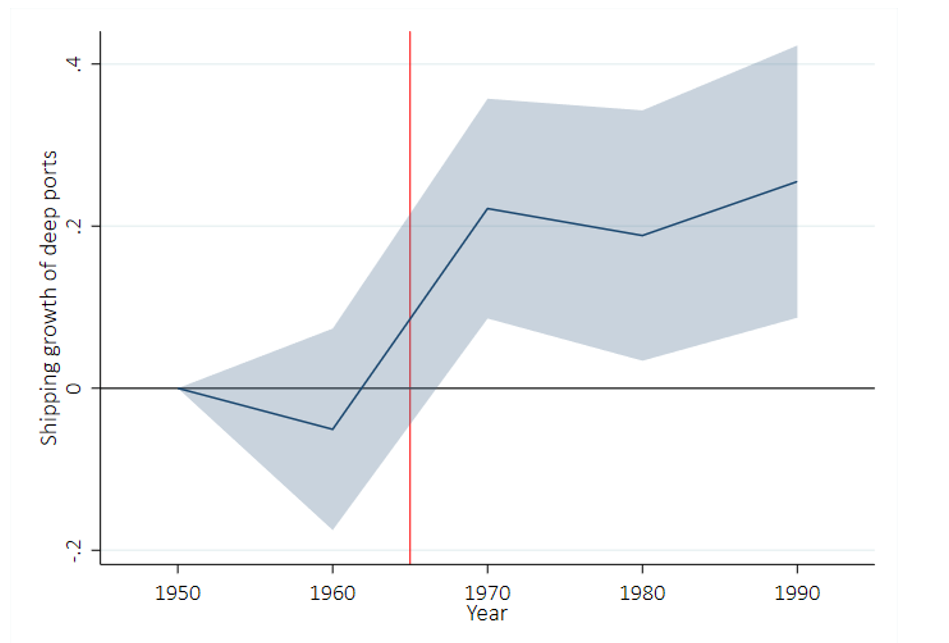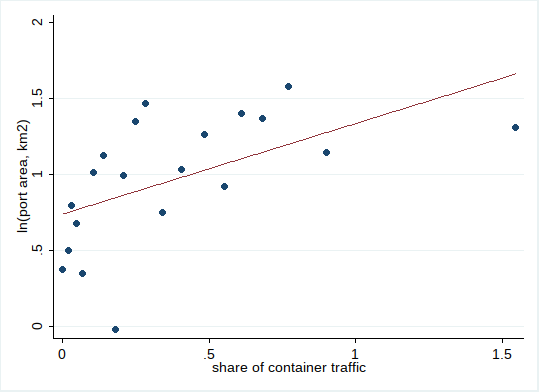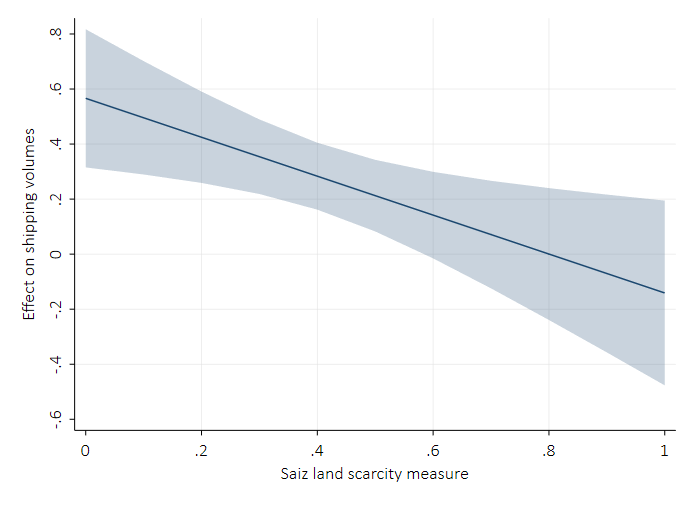
There are large potential gains to improving ports, but space constraints and other costs affect who benefits from port infrastructure
More than 80% of goods are transported by ship (UNCTAD 2019). Yet, many major global shipping hubs operate with very little slack capacity, limiting their ability to adjust to shocks (Rivero 2021). Others lack the infrastructure to accommodate mega container ships crucial to global trade. As western firms try to reduce trade ties with China, the scarcity of deep ports in other Asian countries is quickly emerging as a bottleneck (Edgecliffe-Johnson et al. 2023).
Increasing port capacity may sound like a natural solution, however, the expansion of seaports across the globe has become difficult (The Economist 2023). Port development faces a number of challenges: ports need to be deep, they require vast amounts of land, they create pollution, and they do not necessarily create economic benefits for their own city. In a new study, we show how these factors affect the location and development of ports worldwide, and how this in turn impacts economic growth (Ducruet, Juhász, Nagy, Steinwender 2023).
Ports need to be deep
Port depth became important in the late 1960s, when containerisation was introduced. Putting cargo in standardised boxes reduced ship turnaround times by 70-95% (Port of San Francisco 1971, Kahveci 1999). This led to substantial reductions in transshipment costs (Rodrigue 2016), especially when large ships were used. Since shipping companies wanted to take advantage of these transshipment cost reductions, they started building larger ships: the average size of newly-built container ships increased by 402% between 1960 and 1990 (Haworth 2020). However, large ships require deep ports (Brooks et al. 2021). Figure 1 shows how depth started to matter for shipping: in the 1970s, deep ports (at least 30ft/10m) experienced a shipping boom relative to shallower ports.
Figure 1: Deep ports grew after containerisation

Depth continues to be an important factor determining the success of ports, as ships are becoming ever larger. While China has 76 port terminals that can accommodate ships carrying more than 14,000 20ft containers, south and south-east Asian countries have just 31 altogether (Edgecliffe-Johnson et al. 2023).
Container ports require vast amounts of land
Fast turnaround times in container ports can only be achieved by building large terminals (Rodrigue 2016, p. 118). To illustrate this, we hand-coded the land area of ports from Google Earth. Figure 2 shows that ports with a large share of container traffic occupy substantially more land than ports handling other cargo.
Figure 2: Container ports occupy large areas of land

As soon as cargo started to become containerised, the increased land requirement created a crisis among previously successful ports adjacent to densely built-up cities, such as San Francisco or New York (e.g. Port of San Francisco 1971, Corbett 2010, p. 164). In contrast, new port cities that did not face these constraints developed successfully, such as Seattle or Oakland (e.g. Property Book 1961, 1973). Figure 3 shows that this pattern holds more generally. We calculated the scarcity of land in port cities based on geographical features such as mountains or water, and related this measure to the city’s shipping growth after containerisation. According to Figure 3, cities where land was scarce (i.e. to the right of the graph) did not expand shipping. Thus, the post-containerisation shipping boom was fully driven by land-abundant cities (i.e. those to the left of the graph).
Figure 3: Only land abundant port cities saw their shipping flows increase after containerisation

Ports create pollution
Ports also create large-scale local disamenities such as noise, water, soil, and air pollution. In Hong Kong, more than half of sulphur dioxide emissions are related to shipping (OECD 2014, p. 17). Marquez and Vallianatos (2012) estimate the economic cost of pollution emitted by the ports of Los Angeles and Long Beach to be $30 billion annually (including both the economic cost associated with deaths as well as medical care for illnesses and missed school and work days). These environmental concerns have even led to a stop to port expansions in Piraeus, Greece, and Veracruz, Mexico (The Economist 2023).
Ports do not create economic benefits for their own cities
Did port cities benefit from the development of their ports? Policy makers in rich and poor countries alike spend heavily on port development, suggesting that they believe that the gains to developing port infrastructure are high. We examine this question by comparing the population growth of deep and shallow port cities after containerisation became available in the late 1960s. We would expect to see port cities that successfully adopted containerisation to grow as they reap the benefits of port infrastructure.
Surprisingly, however, this is not confirmed by the data. Successful container port cities do not experience population inflows. In our study, we show that this is driven by the significant costs of port development: while port cities do become more attractive as they are more integrated into the global transport network, these positive effects are offset by port cities becoming less attractive due to scarcity of land, and because of the pollution port activities entail.
Port cities benefit connected surrounding cities
Ports, however, do benefit surrounding cities: these cities gain from better access to the world economy, while not having to face the cost of port development themselves. This suggests that the location of ports matters for the economic growth and welfare of nearby cities. Which ports get developed affects shipping patterns around the world, as well as how economic growth is distributed across cities and countries globally.
We illustrate this by analysing China’s Maritime Silk Road project. As part of the Belt and Road Initiative, the Chinese government subsidises and invests in a number of African, Asian and European ports (Koenig et al. 2023). Our analysis estimates that this initiative will severely change shipping patterns in Asia. Most striking is the effect on Singapore, which we expect to lose shipping to nearby Asian ports. Despite this loss in shipping, however, Singapore is predicted to gain economically: By using the scarce land on the island in sectors in the economy that are more productive, such as the service sector, Singapore’s GDP would actually increase, rather than fall.
The future of port development
Our analysis sheds light on some potential factors policymakers around the globe need to weigh as they grapple with port development.
First, our findings raise the question of whether ports today are located optimally. In light of the land intensity of port development, our analysis questions whether some of the world’s most expensive cities such as Hong-Kong and Singapore should continue to specialise heavily in port activities. While these cities arguably benefited enormously from their position as important ports historically, subsequent productivity growth outside the port sector has made the opportunity costs of directing resources toward port development high. This suggests that Hong Kong and Singapore should follow the path of London and New York: once the major hubs of the global shipping network, these cities have directed their local resources toward higher value-added activities such as financial services. An emerging template in parts of Asia are the “global hub-port cities” (Lee et al. 2008) that develop port infrastructure at the urban outskirts, while downtown areas specialise in advanced services. Yangshan island (Shanghai), Jurong island (Singapore), New Priok (Jakarta), and Nhava Sheva (Mumbai) are just a few recent examples.
Second, in many developing countries, a key constraint to port development may be frictions in the land market (Sood 2022) that impede port development. As the global economy grapples with a new geopolitical reality, and an increased focus on supply chain resiliency, port development should be high on policymakers’ minds.
References
Brooks, L, N Gendron-Carrier, and G Rua (2021), “The Local Impact of Containerization.”, Journal of Urban Economics, 126(C).
Corbett, M (2010), The History and Transformation of the Port of San Francisco, 1848-2010. San Francisco Architectural Heritage.
Ducruet, C, R Juhász, D Nagy and C Steinwender (2023), “All Aboard: The Effects of Port Development.” Mimeo, Available here.
Edgecliffe-Johnson A, C Ho-Him, M Stabe, O Telling and Y Yang (2023), “China’s ports dominance undermines western aims to loosen trade ties”, Financial Times, Available here.
Haworth, R B (2020), “Miramar ship index.”
Kahveci, E (1999), “Fast Turnaround Ships and Their Impact on Crews.”
Koenig, P, Y Pigné, S Poncet, M Sanch-Maritan and C Duvallet (2023), “Sold to china: Container traffic in the port of piraeus.” Technical report.
Lee, S W, D W Song and C Ducruet (2008), “A tale of Asia’s world ports: the spatial evolution in global hub port cities.” Geoforum, 39(1): 372-385.
Marquez, J N and M Vallianatos (2012), “Importing Harm: U.S. Ports’ Impacts on Health and Communities.” Technical report, Trade, Health and Environment Impact Project.
OECD (2014), “The Competitiveness of Global Port Cities.” Technical report, OECD Publishing.
Port of San Francisco (1971), “San Francisco Port Needs, Shipping and Area Requirements.” Technical report, Port of San Francisco.
Property Book (1961), Port of Seattle Public Records Office.
Property Book (1973), Port of Seattle Public Records Office.
Rivero N (2021), “Shipping containers are piling up high on the streets of Long Beach, California”, Quartz, Available here.
Rodrigue, J (2016), The Geography of Transport Systems. Taylor & Francis.
Sood, A (2022), “Land Market Frictions and Manufacturing in India”, University of Toronto (mimeo).
The Economist (2023), “Investments in ports foretell the future of global commerce.” The Economist.
UNCTAD (2019), “Review of Maritime Transport.” Technical report, United Nations Publication.




